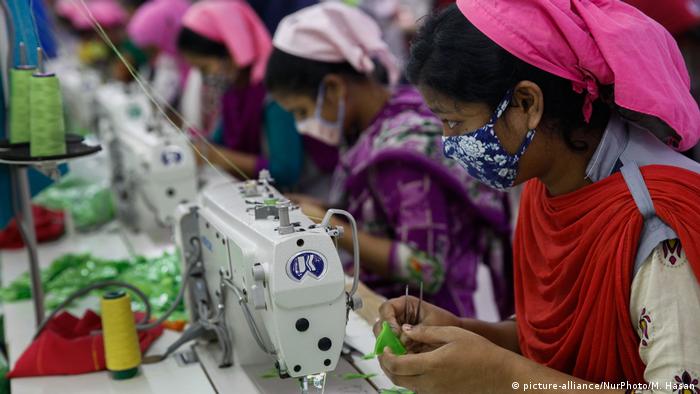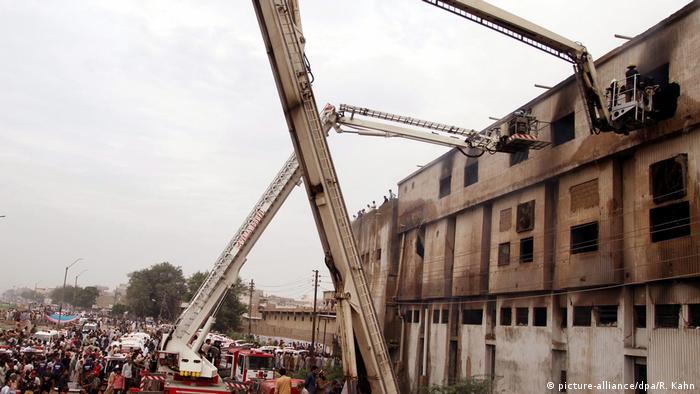As garment workers toil under exploitative working conditions, FEMNET works toward greater transparency in the fashion industry. Ahead of the German Sustainability Award, the NGO's director tells DW what must change.
The global fast fashion industry is often called out for the exploitative working conditions in its factories that are staffed primarily by impoverished women — especially in Asia. Many of these workers toil for little pay and have few rights, largely so clothing manufacturers in Europe and the US can keep costs low.
The industry again came under the spotlight recently as a German court case sought to determine whether local discount clothing manufacturer KiK should be held responsible for the poor working conditions at its supplier company in Pakistan.
In 2012, a fire killed 258 people in the Ali Enterprises textile factory in Karachi. It's the first case of its kind held in Germany and will determine whether corporations should be held accountable for the working conditions of their suppliers abroad.
DW's Sarah Hucal spoke with Dr. Gisela Burckhardt, director of FEMNET, an NGO that works for women's rights in the garment industry in Asia, and a member of the 2018 jury selecting the German Sustainability Award, which recognizes companies and NGOs that encourage social and ecological responsibility. They talked ahead of the annual German Sustainability Award ceremony on December 7 about the challenges and potential for change in the garment industry.
Gisela Burckhardt: Working conditions in the textile industry are very bad. We have discrimination against women, especially in India and Bangladesh. Women are sexually harassed and the payment is very, very low. Even though in Bangladesh the minimum wage increased from about 60 euros to 85 euros (per month) in December, it is not a sufficient living wage and women need to work overtime to survive. We also have the problem of a lack of organization in the factories. If women try to organize themselves in trade unions, they are normally threatened by the management and have to leave the factory. These are some of the problems that have not been resolved.
Why are more women than men affected in this industry?
About 80% of the workforce in the clothing industry is women, with the exception of Pakistan. The industry wants to hire women because they are seen as docile and they might not organize very easily. When they come home, for example, they might not be able to go to trade union meetings because they have so much to do. It's a very patriarchal society in India and Bangladesh, so women are used to not being treated as they should be — as human beings. This also makes it easier in the factory — bosses shout at them and treat them differently than men.
Some people might ask "If the working conditions are so horrendous and wages are low, what keeps women working in this industry?” What would you say to them?
It's simply because of poverty. There are not many work opportunities and it is very difficult for women to find jobs in other industries. Also, a job in the textile industry is much better than working in stone cutting, for example, or in a household as a housemaid because there is more danger of being harassed by men in the household. In China, you can see that many women quit the textile industry and go into the electronics industry if they have the opportunity, because they are paid better. I think it depends very much on the local situation and the possibilities for women to find a well-paid job.
In 2012, German textile company KiK worked with a supplier in Pakistan whose factory caught fire, leading to the deaths of 258 people. Do you believe buyers like KiK should be held responsible for the working conditions in their subsidiary or supplier companies abroad? How might it change the industry if they were?
The case of KiK is unique because KiK was more or less the only buyer in the factory — they had 80% of the orders, which is very rare. Usually, one company would cover just 5-10% of demand in a factory. That makes them more responsible because they are more or less the only buyer. What is unique is that normally when you have human rights violations like this fire, the case can only go to court in the country where it happened. The buyer has never had to be attached to it or take any responsibility. It is unique that the German court now has to look at Pakastani law to see if they have any kind of responsibility. I think it's in the interest not only of consumers and workers, but even of the industry itself to know what its duties are. What is our duty to care about working conditions in the factory? This is the due diligence they have to do, and it needs to be defined by law. If a company can be sued for violating their responsibilities, I think the working conditions in factories will quickly change.
Read more: Rana Plaza disaster: jobless and hopeless five years on
What other suggestions does FEMNET have when it comes to reforming the industry?
We are working in many different areas. At FEMNET, we support urgent appeals in cases where there are accidents in these factories or there are human rights violations. Our partners in the countries of production refer to us to see which companies in Germany are placing orders, and we address the issue with them here. If they don't react, normally we make it public, but we first do very thorough research about what has happened and who is responsible in the case of these working violations. We are also working in the field of education to raise awareness among fashion students and others at 30 to 40 German universities.
What can consumers do to make the industry more sustainable?
What we ask them to do is firstly think about whether they need to have new clothes at all. There is too much production in the world and 60% of all clothes produced are not even worn — they will be thrown away. So let's have less consumption and make sure the clothes that are produced are done so under better working conditions and with better payment. That's the first point I would make. You can buy second-hand clothes, for example. And if you definitely want to buy new ones, you can look for clothes which have certain labels, like Fair Trade and others; there are many certifications that contribute to — although they don't necessarily guarantee — better working conditions.


